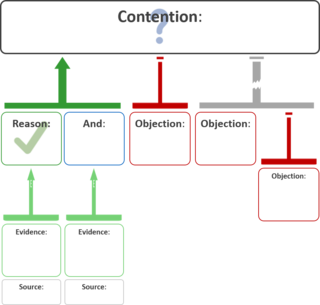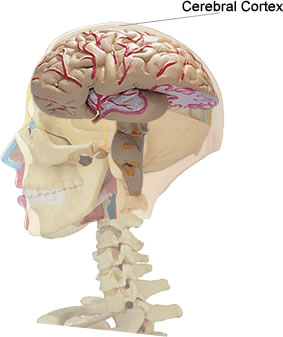
A design is the concept of or proposal for an object, process, or system. Design refers to something that is or has been intentionally created by a thinking agent, though it is sometimes used to refer to the nature of something – its design. The verb to design expresses the process of developing a design. In some cases, the direct construction of an object without an explicit prior plan may also be considered to be a design. A design is expected to have a purpose within a certain context, usually having to satisfy certain goals and constraints, and to take into account aesthetic, functional, economic, environmental or socio-political considerations. Typical examples of designs include architectural and engineering drawings, circuit diagrams, sewing patterns, and less tangible artefacts such as business process models.
Systems theory is the transdisciplinary study of systems, i.e. cohesive groups of interrelated, interdependent components that can be natural or artificial. Every system has causal boundaries, is influenced by its context, defined by its structure, function and role, and expressed through its relations with other systems. A system is "more than the sum of its parts" when it expresses synergy or emergent behavior.

Creativity is a characteristic of someone that forms something novel and valuable. The created item may be intangible or a physical object. Creativity enables people to solve problems in new or innovative ways.
Scientific evidence is evidence that serves to either support or counter a scientific theory or hypothesis, although scientists also use evidence in other ways, such as when applying theories to practical problems. Such evidence is expected to be empirical evidence and interpretable in accordance with the scientific method. Standards for scientific evidence vary according to the field of inquiry, but the strength of scientific evidence is generally based on the results of statistical analysis and the strength of scientific controls.
Bloom's taxonomy is a set of three hierarchical models used for classification of educational learning objectives into levels of complexity and specificity. The three lists cover the learning objectives in cognitive, affective and psychomotor domains. The cognitive domain list has been the primary focus of most traditional education and is frequently used to structure curriculum learning objectives, assessments and activities.

In its most common sense, methodology is the study of research methods. However, the term can also refer to the methods themselves or to the philosophical discussion of associated background assumptions. A method is a structured procedure for bringing about a certain goal, like acquiring knowledge or verifying knowledge claims. This normally involves various steps, like choosing a sample, collecting data from this sample, and interpreting the data. The study of methods concerns a detailed description and analysis of these processes. It includes evaluative aspects by comparing different methods. This way, it is assessed what advantages and disadvantages they have and for what research goals they may be used. These descriptions and evaluations depend on philosophical background assumptions. Examples are how to conceptualize the studied phenomena and what constitutes evidence for or against them. When understood in the widest sense, methodology also includes the discussion of these more abstract issues.

Constructivism in education is a theory that suggests that learners do not passively acquire knowledge through direct instruction. Instead, they construct their understanding through experiences and social interaction, integrating new information with their existing knowledge. This theory originates from Swiss developmental psychologist Jean Piaget's theory of cognitive development.

Problem solving is the process of achieving a goal by overcoming obstacles, a frequent part of most activities. Problems in need of solutions range from simple personal tasks to complex issues in business and technical fields. The former is an example of simple problem solving (SPS) addressing one issue, whereas the latter is complex problem solving (CPS) with multiple interrelated obstacles. Another classification of problem-solving tasks is into well-defined problems with specific obstacles and goals, and ill-defined problems in which the current situation is troublesome but it is not clear what kind of resolution to aim for. Similarly, one may distinguish formal or fact-based problems requiring psychometric intelligence, versus socio-emotional problems which depend on the changeable emotions of individuals or groups, such as tactful behavior, fashion, or gift choices.
Reflective practice is the ability to reflect on one's actions so as to take a critical stance or attitude towards one's own practice and that of one's peers, engaging in a process of continuous adaptation and learning. According to one definition it involves "paying critical attention to the practical values and theories which inform everyday actions, by examining practice reflectively and reflexively. This leads to developmental insight". A key rationale for reflective practice is that experience alone does not necessarily lead to learning; deliberate reflection on experience is essential.
Design science refers to a scientific, i.e. rational and systematic, approach to designing. An early concept of design science was introduced in 1957 by R. Buckminster Fuller who defined it as a systematic form of designing which he applied especially in innovative engineering design. The concept has been more broadly defined by the Design Science journal as “quantitative and qualitative research in the creation of artifacts and systems, and their embedding in our physical, virtual, psychological, economic, and social environment”.

An argument map or argument diagram is a visual representation of the structure of an argument. An argument map typically includes all the key components of the argument, traditionally called the conclusion and the premises, also called contention and reasons. Argument maps can also show co-premises, objections, counterarguments, rebuttals, and lemmas. There are different styles of argument map but they are often functionally equivalent and represent an argument's individual claims and the relationships between them.
Design science research (DSR) is a research paradigm focusing on the development and validation of prescriptive knowledge in information science. Herbert Simon distinguished the natural sciences, concerned with explaining how things are, from design sciences which are concerned with how things ought to be, that is, with devising artifacts to attain goals. Design science research methodology (DSRM) refers to the research methodologies associated with this paradigm. It spans the methodologies of several research disciplines, for example information technology, which offers specific guidelines for evaluation and iteration within research projects.

Analytical skill is the ability to deconstruct information into smaller categories in order to draw conclusions. Analytical skill consists of categories that include logical reasoning, critical thinking, communication, research, data analysis and creativity. Analytical skill is taught in contemporary education with the intention of fostering the appropriate practises for future professions. The professions that adopt analytical skill include educational institutions, public institutions, community organisations and industry.
Critical systems thinking (CST) is a systems approach designed to aid decision-makers, and other stakeholders, improve complex problem situations that cross departmental and, often, organizational boundaries. CST sees systems thinking as essential to managing multidimensional 'messes' in which technical, economic, organizational, human, cultural and political elements interact. It is critical in a positive manner because it seeks to capitalize on the strengths of existing approaches while also calling attention to their limitations. CST seeks to allow systems approaches such as systems engineering, system dynamics, organizational cybernetics, soft systems methodology, critical systems heuristics, and others, to be used together, in a responsive and flexible way, to maximize the benefits they can bring.

Compendium is a computer program and social science tool that facilitates the mapping and management of ideas and arguments. The software provides a visual environment that allows people to structure and record collaboration as they discuss and work through wicked problems.

Derek Cabrera is an American systems theorist and cognitive scientist who applies systems-based concepts to the development of models in human development and learning (education), organizational learning design, management and leadership, organizational change. Models he has formulated include DSRP, MAC, VMCL and NFST. He is also the inventor of MetaMaps and ThinkBlocks.
ThinkBlocks are a tactile manipulative educational tool invented by American educational theorist Derek Cabrera. Cabrera invented the blocks as a way to teach his graduate and doctoral students systems thinking at Cornell University. ThinkBlocks are designed to model concepts and build thinking skills based on the DSRP theory and method of thinking. This theory posits that four patterns, Distinctions, Systems, Relationships, and Perspectives, underlie all cognition, that they are universal to the process of structuring information, and that people can improve their thinking skills by learning to use the four elements explicitly. Students assign concepts to blocks by writing on them with dry-erase markers, and then associate them with other concepts by using the multi-nesting, barbell, and looking glass (translucent) properties of the blocks. They were originally white, magnetic dodecahedra in three nested sizes, with one reflective side. In 2012, a new translucent cube-shaped version of the block was introduced.

Critical realism is a philosophical approach to understanding science, and in particular social science, initially developed by Roy Bhaskar (1944–2014). It specifically opposes forms of empiricism and positivism by viewing science as concerned with identifying causal mechanisms. In the last decades of the twentieth century it also stood against various forms of postmodernism and poststructuralism by insisting on the reality of objective existence. In contrast to positivism's methodological foundation, and poststructuralism's epistemological foundation, critical realism insists that (social) science should be built from an explicit ontology. Critical realism is one of a range of types of philosophical realism, as well as forms of realism advocated within social science such as analytic realism and subtle realism.

Problem structuring methods (PSMs) are a group of techniques used to model or to map the nature or structure of a situation or state of affairs that some people want to change. PSMs are usually used by a group of people in collaboration to create a consensus about, or at least to facilitate negotiations about, what needs to change. Some widely adopted PSMs include
Systemic intervention is a deliberate operation by intervening agents that seeks people to make alterations in their lives in psychology. This analyses how people deal with challenges in the contemporary era, including their power relations and how they reform relationship with others. Midgley ventured new approach to systems philosophy and social theory that could develop variety usage of the multiple strands of systemic thinking to systemic intervention. Scientific methods could be used as a segment of the intervention practice. However, it does not deal with all of the problems of systemic thinking as well as the science complexity.





































